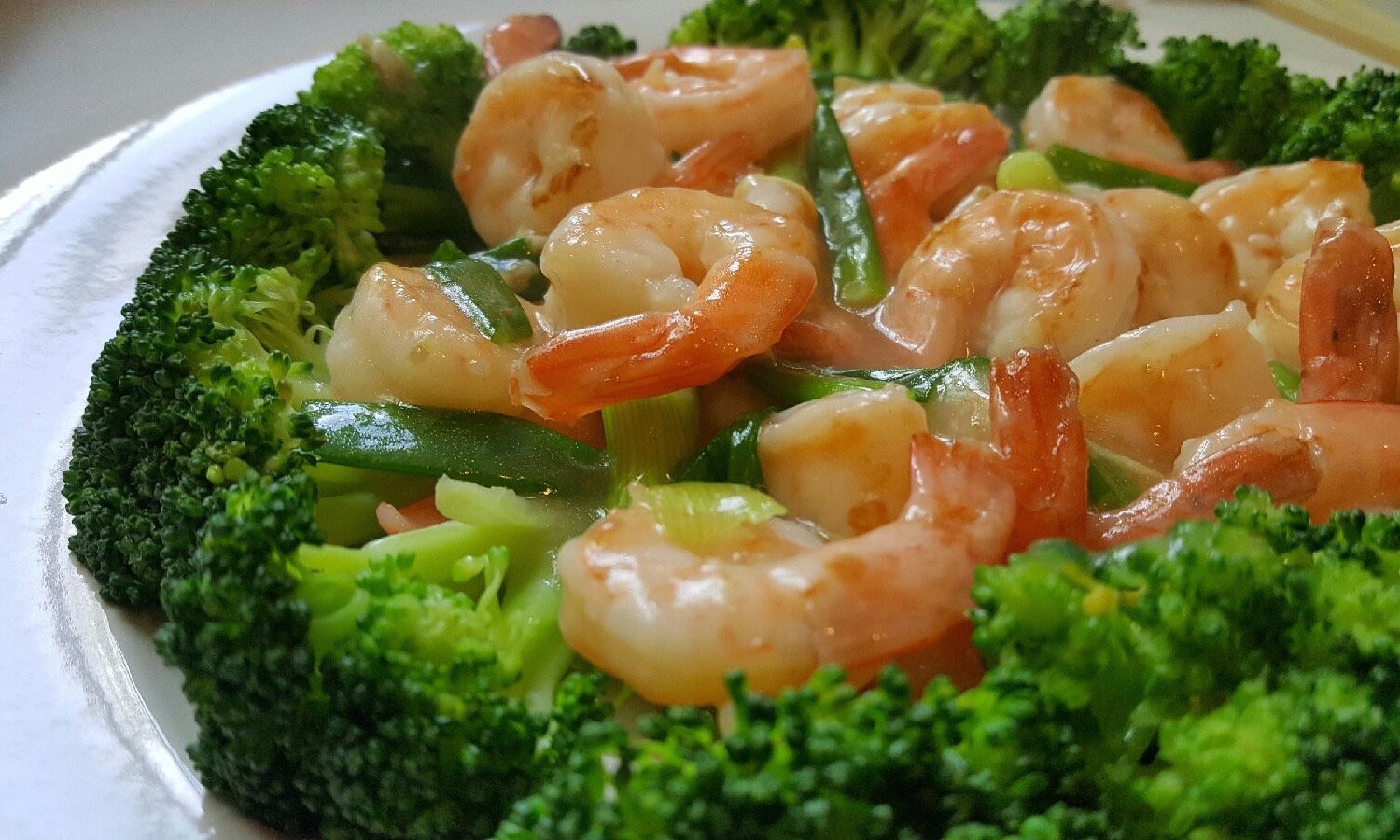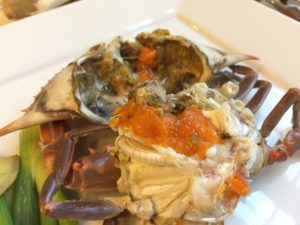
Full confession: I killed eight crabs one Saturday.
At the time, all I was focused on was prepping them to cook. My friend Chi had bought the crabs and we were to have a crab fest. Did I know how to prepare them? She asked earlier.
Of course, I said. I am a crab slayer.
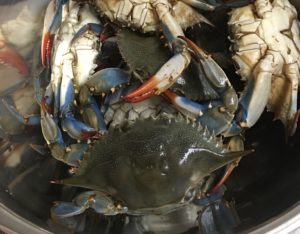
Popo taught me when I was in my early teens. I practiced the skill on the huge, green crabs popular in Singapore. Those fellas are aggressive. Their eyes rotate and are watching you. They have large, fat claws that won’t let go once they get you until, according to Popo, thunder sounds. It will draw blood, she warned. In Singapore, they tie up the claws but you still have to be careful the legs don’t stab you. They have eight legs and a pokey shell. I only have two, rather soft, hands.
The ones Chi bought were Maryland blue crabs. Sissies compared to our green giants Maryland blues are half the size and not as angry. Their blue claws were untied and ready to attack. But–armed with bravado and chopsticks–I was ready for battle. Here they are, pictured below.
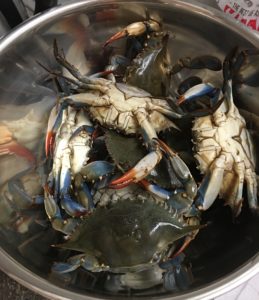
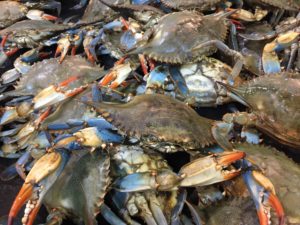
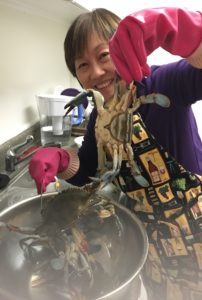 Look, I told Chi, here’s how you pick them up! I grabbed one by a leg. The other crabs clung on, making it hard to disentangle them. It was funny. Click! Click! Chi snapped some photos. I then prepped and cooked the crabs. Chi shrieked when I stabbed and cracked them but she–and I–happily ate them, enjoying ourselves tremendously.
Look, I told Chi, here’s how you pick them up! I grabbed one by a leg. The other crabs clung on, making it hard to disentangle them. It was funny. Click! Click! Chi snapped some photos. I then prepped and cooked the crabs. Chi shrieked when I stabbed and cracked them but she–and I–happily ate them, enjoying ourselves tremendously.
Later I posted a photo of myself with the string of crabs. I had merely lifted them out from the basin but a smudge in the photo made it look like I was cooking them.
Do you know that the Torah teaches that we should not cook creatures while they are alive? My Jewish friend Aviya gently chided me. Crabs are not kosher but she was looking out for my soul. And for the crabs. Those weren’t cooked alive! I defended myself. But I admit, I did cook one by boiling it. Chi made me do it. To test the difference in taste.
Feeling regretful and with head hung low I immediately googled the best and most humane way to kill these creatures.
You don’t want to boil them alive. Oops.
And you don’t want to pull out the legs or claws first. It stresses out the crab. I pictured how it’d be if someone pulled out a chicken’s leg before slitting its throat. It does sound barbaric, doesn’t it? It also affects the taste.
Turns out Popo taught me well. Stab them right at the heart. Instant death, more or less. The more squeamish and indecisive you are, the longer the process will take if you miss the spot. I started to get a sense of respect for deer hunters and the likes of Katniss Everdeen.
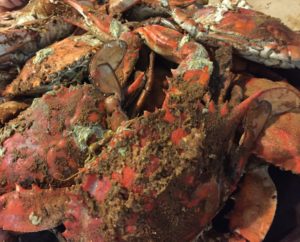 There were suggestions to keep crabs chilled to numb them. Shanghai crabs are kept in refrigerators until they are ready to be cooked. (These are steamed alive.) A crab seller once told me to keep the crab in darkness covered with a damp towel. They can keep for a day or two, but any longer would reduce their amount of meat. Makes sense as they’d be starving and stressed.
There were suggestions to keep crabs chilled to numb them. Shanghai crabs are kept in refrigerators until they are ready to be cooked. (These are steamed alive.) A crab seller once told me to keep the crab in darkness covered with a damp towel. They can keep for a day or two, but any longer would reduce their amount of meat. Makes sense as they’d be starving and stressed.
I’ll remember all these when I cook crab the next time. Or I’ll avoid the moral dilemma and go to my favorite crab shack–Captain Pells, on Lee Highway, Fairfax, Va. They steam their crab and add Old Bay Seasoning (pictured here.) It’s the best! I must ask if they kill them before steaming. Or not.
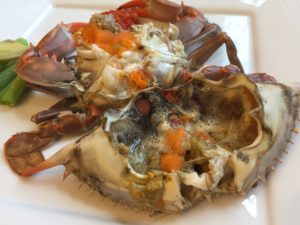
Cooking crab
There is no better way to eat crab than to cook them fresh. By fresh I mean alive, eyes watching you alive. A dead crab belongs in the trash. You have no idea how long they’ve been dead and it just won’t be any good.
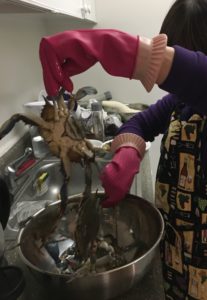 This means you will have to learn how to capture, kill and clean. It’s easy, with some practice. Poke at their claw with a chopstick and it will automatically cling on. With a twist of the wrist turn the crab upside down. Move the body with the claws facing away from you.
This means you will have to learn how to capture, kill and clean. It’s easy, with some practice. Poke at their claw with a chopstick and it will automatically cling on. With a twist of the wrist turn the crab upside down. Move the body with the claws facing away from you.
Grab one by securely holding on to the middle of the body. The claws can’t reach behind; they can’t stretch. Once you secure the crab this way, hold it down. It can’t get you with its claws. The only thing to watch out for are other crabs nearby!
How to kill the crab
 Sorry, I can’t say this any more delicately. Underneath the crab is a flap. It’s called an apron, how cute is that? The male’s is narrow and the female’s is wide. You can see the female flap in the crabs pictured here, it has a point at the top. One website described the male apron looking like the Washington Monument and the female like the Capitol! Quite true.
Sorry, I can’t say this any more delicately. Underneath the crab is a flap. It’s called an apron, how cute is that? The male’s is narrow and the female’s is wide. You can see the female flap in the crabs pictured here, it has a point at the top. One website described the male apron looking like the Washington Monument and the female like the Capitol! Quite true.
Pull the flap back by sliding a knife or chopstick under it.
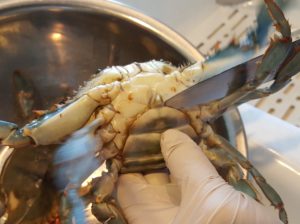
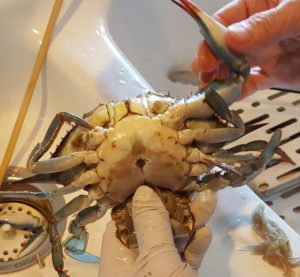
If you are freakish or an animal activist, please don’t read this anymore. With a chopstick, poke hard right through the middle of the underbelly and stab. Hit the spot right where there is a deep crevice. The shell is thinner there. It will kill the crab. Popo taught me that. After that if the crab moves, it’s just the muscles. You still have to be careful of the pincers.
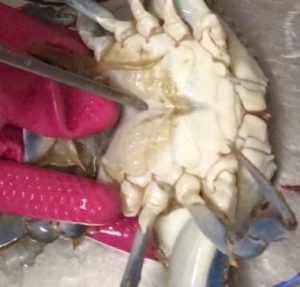
Lightly brush off any dirt and rinse quickly. Don’t submerge the crab in water and wash away all its taste. Brush crab while it is still intact.
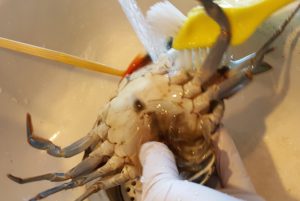
Prepping the crab
Peel or use scissors to cut off the apron. All the gucky stuff you don’t want to eat is in that apron.
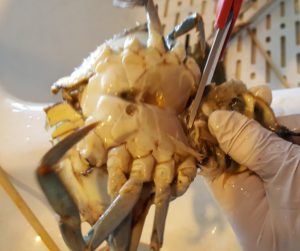
Hold the four legs on one side with one hand, and with the other hand pull open the shell to separate it from the body.

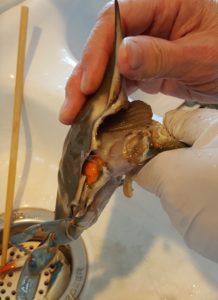
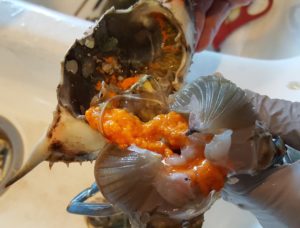
Peel off gills (grey spongy part). If the crab is big–like our green ones–you can sometimes find a little bag under the shell. You can peel that off. The orange part is the roe, which is what aficionados of Shanghai crab pay big money for. Some people are turned off by it. Rinse crab off quickly and set cleaned crab aside in a plate.
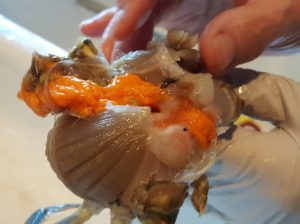
Cooking crab
Typically I’d either steam the crab or fry it in the popular style that I like, Singapore Chili Crab. Chi was excited about making a hotpot with crab and so we cooked the crab in three different ways.
Boiling: We put some crab in soup, boiled it until the blue claws turned orange. Chi had made a stock with radish and a sachet of Chinese herbs. The crab made the soup was very tasty.
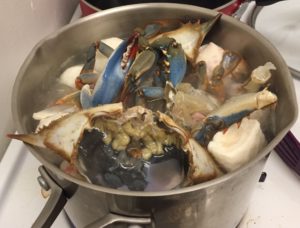
Steaming: We steamed the crabs in her rice cooker. I thought this tasted the sweetest and richest. When served the crab is not dripping with stock. This was my favorite of all three. Usually, we add ginger, spring onion, and rice wine (or brandy) to the tray before steaming.

Typically when we steam food in Chinese cooking we use a wok, fill it with water, put in a rack (which you can buy from any Chinese grocery store for less than $5) and use a wok cover. Bring the water to boil and then add in your plate of crab, cover and steam.
Four crabs can be steamed over medium heat within 10-15 minutes. Once all sides of the crab turned that beautiful orange color, it’s cooked.
Wok covers are a good investment. Look for them in a Chinese grocery store–they are very reasonably priced. Make sure your cover is smaller than your wok so that the water of condensation drips back into wok.
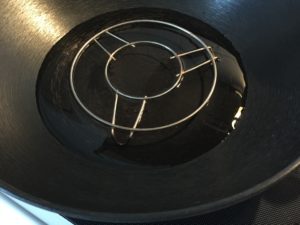
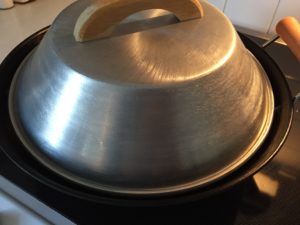
Here’s how the steamed crab looks; the delicious red stuff that is the favorite part of Chinese stays intact. Not boiled away.
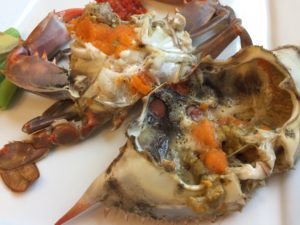
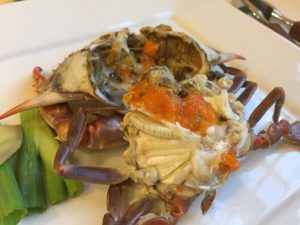
Boiling whole crab: Without removing the shell, we boiled one crab until it turned bright orange, about 5-10 minutes. We cracked it after it was cooked. Chi felt that this would be how she would cook crabs again. There’s no slaying and cracking. Easy for the cook, not for the crab.
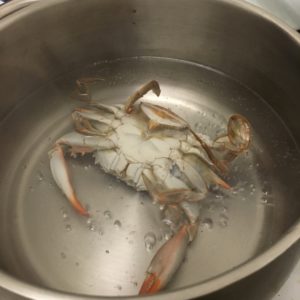
We ate the crabs dipped in chili. Chi dipped some in wasabe. You can also dip crab in melted butter.


